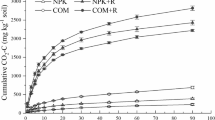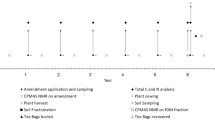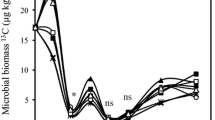Abstract
This paper describes an incubation experiment with homogeneously 14C labeled maize-straw and its insoluble fraction. The role of the soluble fraction in the decomposition process was assessed, using three independently measured characteristics: (1) fractionation of the maize-straw, resulting in kinetically different fractions; (2) microbial biomass C and its 14C activity determined by a fumigation extraction method, and (3) the 14C activity of the released CO2-C. The fumigation extraction method was proved to be useful from 9 days after the application of the maize-straw onwards. The fractionation method yielded a soluble (48%), a (hemi) cellulosic (47%), and a lignin fraction (1%). Nine days after addition of either the complete residue or its insoluble fraction, the microbial biomass C increased from 53 to 337 and 217 mg C kg-1 dry soil, respectively. Similar values were maintained up to day 40. The large increase in microbial activity was accompanied by a N-immobilization of 65 and 29 mg N Kg-1 dry soil for the maize-straw treatment and its insoluble fraction, respectively, resulting in biomass C/N values of 5.5 and 5.6 A genuine priming effect (10 and 7% of the total CO2-C production) on the mineralization of native soil organic C was caused by an increase in decomposition of the native C rather than by an increase in turnover of the microbial biomass in the soil amended with maize straw. The soluble fraction caused a ‘priming effect’ on the decomposition of the less decomposable cell-wall fraction. Calculations by nonlinear regression confirmed this observation.
Similar content being viewed by others
References
Amato, M 1983 Determination of Carbon 12C and 14C in plant and soil. Soil Biol. Biochem. 5, 611–612.
Amato, M and Ladd, J N 1988 Assay for microbial biomass based on ninhydrin-reactive nitrogen in extracts of fumigated soils. Soil Biol. Biochem. 20, 107–114.
Bremner J M and Mulvaney C S 1982 Nitrogen-total. In Methods of Soul Analysis, Part 2. Eds. C A Black et al. Agronomy Monograph No. 9, 595–624.
Brookes, P C, Ocio, J A and Wu, J 1990 The soil microbial biomass: its measurement, properties and role in soil nitrogen and carbon dynamics following substrate incorporation. Soil Microorganisms 35, 39–51.
Bundy, L G and Bremner, J M 1972 A simple titrimetric method for determination of inorganic carbon in soils. Soil Sci. Soc. Am. Proc. 36, 273–275.
Dendooven, L 1990 Nitrogen mineralization and nitrogen ycling. PhD Thesis, K.U. Leuven, Belgium. 180 p.
Jenkinson D S 1966 The priming action. In The Use of Isotopes in Soil Organic Matter Studies. Rep. FAO/IAEA Technical Meeting, Brunswick-Völkenrode 1963: 199–207.
Jenkinson, D S, Hart, P B S, Rayner, J H and Parry, L C 1987 Modelling the turnover of organic matter in long-term experiments at Rothamsted. INTECOL bulletin 1987: 15, 1–8.
Kang, B T, Wilson, G F and Sipkens, L 1981 Alley cropping maize (Zea mays L.) and leucaena (Leucaena leucocephala Lam.) in souther Nigeria. Plant and Soil 63, 165–179.
Martens, R 1985 Limitations in the application of the fumigation technique for biomass estimations in amended soils. Soil Biol. Biochem. 17, 57–63.
McGill W B, Hunt H W, Woodmansee R G and Reuss J O 1981 Phoenix, a model of the dynamics of carbon and nitrogen in grassland soils. In Terrestrial nitrogen cycles. Eds. F E Clark and T Rosswall. Ecol. Bull. (Stockholm) 33, 49–115.
Merckx, R and Martin, J K 1987 Extraction of microbial biomass components from rhizosphere soils. Soil Biol. Biochem. 19, 371–376.
Mood, A M, Graybill, F A and Boes, D C 1974 Introduction to the theory of statistics. McGraw-Hill, New York, pp 180–181.
Moormann F R, Lal R and Juo A S R 1974 The soils of IITA. IITA Technical Bulletin No. 3, 26–28.
Ocio, J A and Brookes, P C 1990 An evaluation of methods for measuring the microbial biomass in soils following recent additions of wheat straw and the characterization of the biomass that develops. Soil Biol. Biochem. 5, 685–694.
Ocio, J A Brookes, P C and Jenkinson, D S 1991 Field incorporation of straw and its effects on soil microbial biomass and soil inorganic N. Soil Biol. Biochem. 23, 171–176.
Parton, W J, Schimel, D S, Cole, C V and Ojima, D S 1987 Analysis of factors controlling soil organic matter levels in Great Plains Grasslands. Soil Sci. Soc. Am. J. 51, 1173–1179.
Paul, E A 1984 Dynamics of organic matter in soils. Plant and Soil 76, 275–285.
SAS Institute Inc. 1985 SAS User's Guide: Statistics, 5 edition. SAS Institute Inc. Cary, NC, 957 p.
Vance, E D, Brookes, P C and Jenkinson, D S 1987 An extraction method for measuring soil microbial biomass C. Soil Biol. Biochem. 6, 703–707.
Van Gestel, M, Merckx, R and Vlassak, K 1993 Soil drying and rewetting and the turnover of 14C-labelled plant residues: first order decay rates of biomass and non-biomass 14C. Soil Biol. Biochem. 25, 125–134.
Van Soest, P J 1963 Use of detergents in the analysis of fibrous feeds. II. A rapid method for the determination of fiber and lignin. J. AOAC 46, 829–835.
Van Soest, P J and Wine, R H 1967 Use of detergents in the analysis of fibrous feeds. IV. Determination of plant cell-wall constituents. J. AOAC 50, 50–55.
Van Veen, J A and Paul, E A 1981 Organic carbon dynamics in grassland soils. 1. Background information and computer simulation. Can. J. Soil. Sci. 61, 185–201.
Author information
Authors and Affiliations
Rights and permissions
About this article
Cite this article
Vanlauwe, B., Dendooven, L. & Merckx, R. Residue fractionation and decomposition: The significance of the active fraction. Plant Soil 158, 263–274 (1994). https://doi.org/10.1007/BF00009500
Received:
Accepted:
Issue Date:
DOI: https://doi.org/10.1007/BF00009500




